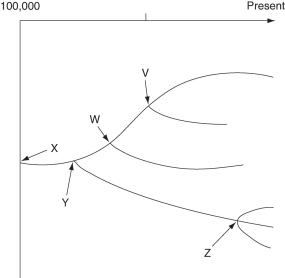Multiple Choice
The following questions refer to the evolutionary tree in Figure 22.2.
The tree's horizontal axis is a timeline that extends from 100,000 years ago to the present; the vertical axis represents nothing in particular. The labeled branch points on the tree (V-Z) represent various common ancestors. Let's say that only since 50,000 years ago has there been enough variation between the lineages depicted here to separate them into distinct species, and only the tips of the lineages on this tree represent distinct species.

-Which statement best describes the evolution of pesticide resistance in a population of insects?
A) Individual members of the population slowly adapt to the presence of the chemical by striving to meet the new challenge.
B) All insects exposed to the insecticide begin to use a formerly silent gene to make a new enzyme that breaks down the insecticide molecules.
C) Insects observe the behavior of other insects that survive pesticide application, and adjust their own behaviors to copy those of the survivors.
D) Offspring of insects that are genetically resistant to the pesticide become more abundant as the susceptible insects die off.
Correct Answer:

Verified
Correct Answer:
Verified
Q13: The following questions refer to the evolutionary
Q24: Which of the following observations helped Darwin
Q27: Which statement about natural selection is most
Q28: Which of the following is not an
Q29: As a young biologist, Charles Darwin had
Q31: The following questions refer to the evolutionary
Q31: Natural selection is based on all of
Q34: Monkeys of South and Central America have
Q35: Which of Darwin's ideas had the strongest
Q36: Which of the following represents an idea